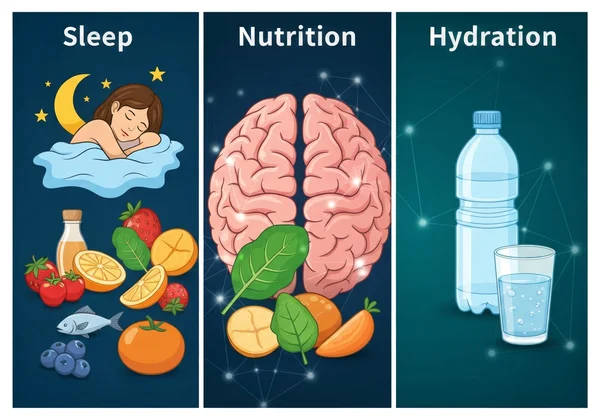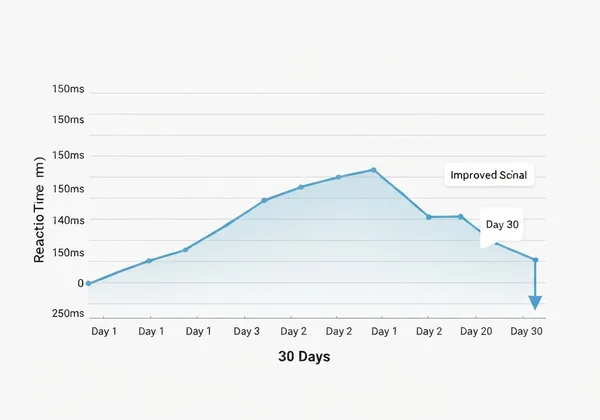30-Day Reaction Time Test Challenge: Improve Your Reaction Speed
Ready to sharpen your reflexes and gain a competitive edge? This 30-day reaction time challenge is your structured, week-by-week plan to measure, understand, and significantly improve your reaction speed. We'll explore everything from daily habits to specific training drills. What is a good reaction time? By the end of this journey, you'll not only know your score but have the tools to make it better. Whether you're a gamer, athlete, or just aiming for better cognitive function, get ready to track tangible progress by taking the initial reaction time test now!
Start Strong: Setting Your Reaction Time Baseline
Every great journey begins with a single step, and in our challenge, that step is establishing your baseline. You can't improve what you don't measure. This initial phase is crucial for understanding your starting point and setting realistic, motivating goals for the next 30 days. It’s a simple, quick process that provides the foundation for everything to come.
Taking Your Initial Reaction Time Test
Before you begin any training, it's essential to get a clear picture of your current reflex speed. This gives you a benchmark to measure your progress against. The best way to do this is with a simple, accurate tool. Head over to our homepage and take the click test five times. Ignore the first result to account for warming up, then calculate the average of the next four. This average is your starting baseline. Write it down!

What is a Good Reaction Time to Aim For?
The average human reaction time to a visual stimulus is around 250 milliseconds (ms). For competitive gamers and professional athletes, scores under 200ms are common, with elite performers often dipping below 150ms. However, "good" is relative. Your goal shouldn't be to match a pro overnight. Instead, aim for consistent improvement. A realistic goal for this 30-day challenge is to shave 15-30ms off your initial baseline score.
Week 1: Consistency & Focus – Building Your Foundation
The first week of our 30 day improvement plan is all about creating a habit. Just like building muscle, improving your neural pathways requires consistent practice. This week, we won’t focus on complex drills but on establishing a routine and honing your mental focus, which are the cornerstones of faster reflexes.
Establishing Your Daily Testing Routine with Our Reaction Timer
Commit to taking the reaction test every single day this week. The key is to do it at roughly the same time each day to create a consistent testing environment. This could be in the morning with your coffee, during a lunch break, or before a gaming session. This daily practice helps your brain become more familiar with the task, turning the reaction process into a more automatic, faster response. Use our free online tool to easily track your daily scores.
Sharpening Your Focus for Accurate Results
Your reaction time is heavily influenced by your level of concentration. Before each test, take 30 seconds to eliminate distractions. Turn off notifications, close other tabs, and take a few deep breaths. Focus solely on the test box, anticipating the color change. This practice of "getting in the zone" not only improves your scores on the test but also translates directly to high-stakes moments in gaming or sports.
Week 2: Fueling Your Reflexes – Lifestyle Habits for Peak Speed
By now, you should have a solid routine. This week, we shift our focus from the test itself to the powerful lifestyle factors that govern your cognitive performance. What you do outside of training has a massive impact on your brain's processing speed. Many people wonder what causes slow reaction time, and often the answer lies in daily habits.

Diet & Nutrition for Optimal Brain Speed
Your brain is a high-performance machine that requires premium fuel. Foods rich in Omega-3 fatty acids (like fish and walnuts), antioxidants (like blueberries and spinach), and flavonoids (like dark chocolate) can support cognitive function. Avoid heavy, processed meals before testing or competing, as they can make you feel sluggish and slow your mental acuity.
The Critical Role of Sleep in Reaction Time
Sleep is non-negotiable for peak performance. When you are sleep-deprived, your cognitive processing slows down dramatically. Studies have shown that even one night of poor sleep can impair reaction time as much as being legally intoxicated. Aim for 7-9 hours of quality sleep per night. You will see a direct and measurable improvement in your daily test scores when you are well-rested.
Hydration: Simple Yet Powerful for Cognitive Performance
Dehydration is a common culprit behind a sudden drop in performance. Even mild dehydration can impair attention, memory, and motor coordination. Keep a water bottle handy throughout the day and make sure you are consistently hydrated. This simple habit is one of the easiest ways to ensure your brain is operating at its full potential.
Week 3: Training & Drills – Actively Improving Your Reflexes
With a solid foundation of consistency and healthy habits, it's time to actively train your reflexes. This week is about engaging in a reaction time training program that pushes your limits. We will introduce specific drills and technical considerations to help you achieve new personal bests.

Beyond the Click: Simple Practice Drills You Can Do
Incorporate simple physical drills into your routine. One classic exercise is the ball drop. Have a friend hold a tennis ball at your shoulder height and drop it without warning. Your goal is to catch it before it bounces. This trains your visual processing and physical response in a real-world scenario. Another great drill is using reaction training apps on your phone that present varied stimuli.
Specialized Training for Gamers and Athletes
If you want to know how to improve reaction time for gaming, start with in-game practice. Use aim trainers like KovaaK's or Aim Lab to practice "flick shots" and target acquisition. For athletes, sport-specific drills are key. Boxers can use a speed bag to improve hand-eye coordination, while tennis players can practice volleying against a wall to shorten their response time. The key is to practice reacting to unpredictable stimuli.
Hardware and Software: Minimizing Latency for Speed
Does FPS affect reaction time? Absolutely. For gamers, ensuring your equipment isn't holding you back is crucial. A monitor with a high refresh rate (144Hz or higher) and a gaming mouse with a high polling rate (1000Hz) will minimize input lag. This ensures the signal from your click reaches the computer faster, giving you a truer measure of your reaction speed on the reaction speed test.
Week 4: Measure & Maintain – Sustaining Your Faster Reaction Time
You've reached the final week of the challenge! Now it's time to analyze your progress and develop a strategy to maintain and continue improving your newfound speed. This week is about cementing your gains and making faster reflexes a permanent part of your skill set.
Analyzing Your Progress: How Far Have You Come?
Take your baseline score from Day 1 and compare it to your average score from this final week. Go back to the reaction timer and take one last set of five tests. Did you hit your goal of shaving off 15-30ms? Celebrate your progress! Seeing this measurable improvement reinforces the effectiveness of your consistent effort and provides motivation to keep going.

Long-Term Strategies for Sustained Speed
The 30-day challenge is just the beginning. To maintain your faster reflexes, you don't need to train intensely every day. Incorporate a daily reaction test into your routine a few times a week to monitor your performance. Continue to prioritize sleep, nutrition, and hydration. Think of reaction time not as a one-time goal but as a skill that you can maintain and sharpen over time.
Beyond 30 Days: Sustaining Your Reaction Speed
Congratulations on completing the 30-Day Reaction Time Challenge! You have built a foundation of consistency, optimized your lifestyle for performance, and engaged in active training to measurably improve your reflexes. You now have a deeper understanding of what it takes to perform at your peak.
This journey doesn't have to end here. Continue using the tools and knowledge you've gained to push your limits even further. Keep tracking your progress, stay consistent with your habits, and never stop challenging yourself. Ready to see how much faster you can get? Start your challenge again and set a new goal!
Frequently Asked Questions About Reaction Time Improvement
What Is the Average Human Reaction Time, and Can Everyone Improve?
The average reaction time for a human is around 250ms. However, this can vary widely based on age, fitness, and alertness. The great news is that yes, virtually everyone can improve their reaction time with consistent practice and healthy lifestyle habits, just like those outlined in our challenge.
Is Reaction Time Genetic, or Can It Always Be Trained?
While genetics can play a role in setting a person's potential baseline, it is not the deciding factor. Neuroplasticity—the brain's ability to reorganize itself by forming new neural connections—means that reaction time is a highly trainable skill. Consistent training strengthens the neural pathways from stimulus to response, making you faster over time.
Besides Gaming, How Else Does Faster Reaction Time Benefit Me?
Faster reflexes have numerous benefits in daily life. It can make you a safer driver, allowing you to brake or swerve more quickly to avoid accidents. It improves performance in many sports, from catching a ball to blocking a punch. It also contributes to overall cognitive health, helping you stay mentally sharp as you age.
How Often Should I Test My Reaction Time After the Challenge?
After completing the 30-day challenge, testing your reaction time 2-3 times per week is a great way to maintain your skills and ensure you aren't slipping. It's a quick and easy mental warm-up that keeps your reflexes sharp. You can always check your progress with our free tool whenever you feel the need for a tune-up.